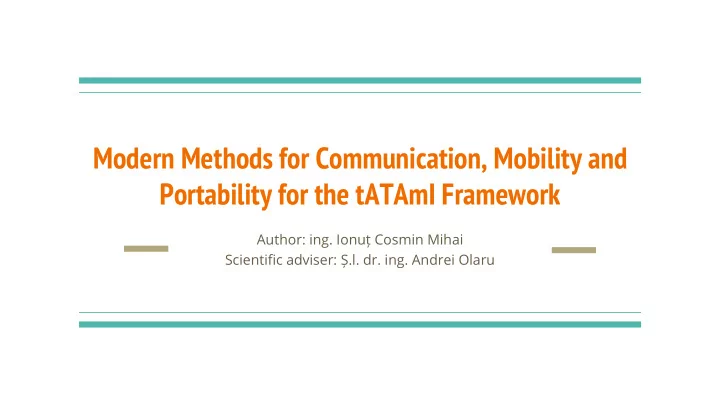

Modern Methods for Communication, Mobility and Portability for the tATAmI Framework Author: ing. Ionuț Cosmin Mihai Scientific adviser: Ș.l. dr. ing. Andrei Olaru
Context and motivation Ambient Intelligence technologies are ● currently expanding Embedded systems are powerful ● enough to run higher level of abstraction MAS-enabled Ambient Intelligence / ● Ubiquitous Computing research is in need of MAS Deployment platforms that are flexible and easy to use 2
What is tATAmI Flexible Multi Agent System deployment framework implemented in Java ● Component-based architecture ○ Several options for the means of inter-agent communication ○ tATAmI back in 2014: ● Local communication ○ JADE based communication ○ PC deployment ○ tATAmI now in 2016: ● Added Websocket communication ○ Added agent mobility ○ Added deployment on Android and Raspbian ○ 3
Objectives for this research - successfully completed Websocket-based communication ● Modern flexible, easy to use technology ○ Agent mobility ● Enables the MMAS paradigm for implementing ambient services ○ Support for Android ● Support for Raspbian ● New components for sensors and actuators ● Enables context-aware applications ○ Integrate the framework on a Raspberry Pi based system ● Architecture changes to support several types of User Interface and ● specialized logging 4
State of the art Multi Agent System frameworks with support for embedded targets ● JIAC / microJIAC (Targeted for embedded) ○ JADE / JADE for Android (The most used) ○ Agent Factory / Agent Factory Micro Edition (Large palette of components) ○ MAS C++ (C++ example) ○ Current MAS Systems aspects to be improved: ● resource consumption adjustment - now it is affordable to use more resources on ○ embedded systems ignore some MAS unnecessary features that are not necessarily needed (e.g. Ontology ○ support) the Micro Editions versions have a reduced set of features : no dynamic class loading, ○ precompiled XML configuration file 5
Websocket communication Full Duplex Communication for the Web ● Increased security ● well known, intense tested ○ no additional ports are required to be opened(only the traditional 80) ○ Encrypted connection due to WSS ○ Increased Client-Server efficiency ● the overhead relative to usual HTTP is reduced up to 1:1000 ○ SOA oriented architecture ● simpler to make the server available ○ 6
Agents mobility A paradigm-specific feature specified in the FIPA standard ● Uses Java serialization but is not enough ● The agent can have transient members ○ Methods for pausing and resuming needed ○ Limitation: raise security issues ● The agent can be corrupted ○ 7
Portable core extraction Extract the functionality that can be used on all target devices ● Add a new component for agent control ● Split the log into agent level log and development level log ● Interfaces for generic HMI (Human Machine Interface) ● 8
Android Implementation Several issues: the only available IPC method is AIDL, not suitable: ● Can’t be ported ○ Considerable overhead for marshalling and serialization ○ Solved by directly including the core library in the application ○ XML Validation bug on Android - not available for now ● Android restricted policy - the resources are kept differently in the ● application context instead of a certain path on disk 9
Raspbian Implementation Basic control from command line with two way Java RMI for framework ● Control Used sensors with several types of interfaces: ● Medium range distance sensor connected to the GPIO pins ○ Accelerometer interfaced through I2C ○ Force analogous sensor interfaced through SPI ○ Electric motors interfaced through GPIO pins ○ Used Pi4J library for Raspberry Pi - tATAmI ● interfacing 10
Testing Individual testing for every hardware component (sensors and motors) ● using Python scripts and simple Pi4J programs Manual checking: ● The websocket server and client loads correctly ○ The Communication between agents works ○ The Mobility works ○ Sensor sample checking against the samples obtained with the python scripts ○ 11
Results Designed SPS Real Maximum SPS tATAmI SPS HC-SR04(Distance sensor, GPIO) N/A 5 4.6 Sensors samples per second ● MMA8452Q(Accelerometer, I2C) 800 647 100 Force sensor(SPI) 200 170 90 from \ to Agent transport speed PC Android Raspbian ● PC 0.34 0.42 4.6 (seconds) Android 0.42 0.4 0.55 Windows 37.8MB Memory footprint ● Android 34.7MB Raspbian 36.9 MB 12
Conclusion & Further development Successfully implemented the project objectives ● Extend the Control component to receive commands ● Implementation of a new ML component (i.e. using TensorFlow) ● Study of the agents behaviour composed of different components ● 13 More sensors components to add ●
Thank You! 14
Recommend
More recommend